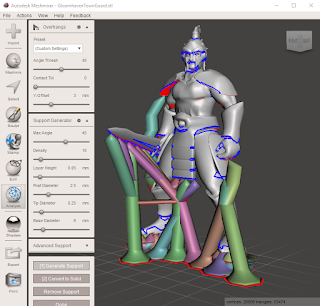New Thing: Trees for Gloomhaven
 |
| Painting this is definitely a problem for future Jason. |
Once again, it's a real challenge to print. The tree is larger and denser than the bush, so it requires even more support and is even harder to get at that support because of how intertwined it is with the tree's branches. I thickened up those branches a fair amount, in an attempt at making them stronger, but I still lost a few branches and leaf clusters while trimming off the supports during my first couple of prints. In the end, the tree looks fine, and now I suppose that I just have 3 unique trees instead of 3 perfect clones ;)
To make it easier to print, I went ahead and cut the tree into upper and lower parts, with a key to make them easier to slot together. The key is very loose, so it should be nice and easy to fit them together, but it will still provide some guidance for gluing.
 |
| That's a lot of support. |
Earlier versions didn't have the cross support, and I ran into issues where individual supports would warp slightly, causing the nozzle to miss them on future layers and leaving piles of spaghetti in the middle of the print. Interestingly, there's enough stuff there that the spaghetti itself was held in place and ended up working moderately well as a support, and I ended up with a very usable print despite that issue. Still, this latest model had a 100% successful print, which is easier to clean up.
That's not to say that cleanup is easy. Every leaf cluster has 5+ support points (generally at the tips of the leaves), and the supports are often thicker than the tree's branches (at the ends, near the leaves). This means that if you just twist and pull the support like you normally would, you'll almost certainly twist and pull the leaves and branches right off of the tree!
 |
| The first snips... |
I've found that the best way to remove the support is to do it in tiny sections. I use my wire cutters to separate the tip of a leaf from its support, which will frequently separate the entire cluster. If the whole cluster doesn't pop off the support, I work my way around it to loosen it all. Then, I snip the support at its thick point, just below where it branches out to support the individual leaves. This means that I'm removing about 1 cm of support at a time, but it minimizes the torque that gets applied to the more delicate parts of the model.
 |
| Yep, there's a tree in there. |
After a lot of work with the wire cutters, I was able to pull out the top half of my tree. Just remember to go slow and that, when you're separating the supports from the leaves, you're not snipping the plastic as much as you're applying balanced upwards and downwards vertical pressure between the leaf and the support, forcing them apart. There shouldn't be too much resistance when snipping those; if you feel a lot of resistance, double check that you aren't also snipping a branch or the main body of a leaf with some other part of your cutters!



Comments
Post a Comment